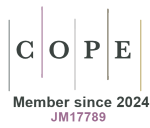Most read articles by the same author(s)
- Andrea Marcellusi, Chiara Bini, Barbara Muzii, Samira Soudani, Alexia Kieffer, Matthieu Beuvelet, Elena Bozzola, Fabio Midulla, Eugenio Baraldi, Paolo Bonanni, Sara Boccalini, Luigi Orfeo, Economic and clinical burden associated with respiratory syncytial virus and impact of universal immunization with nirsevimab in Italy , Global and Regional Health Technology Assessment: Vol. 12 No. 1 (2025): January-December 2025
- Francesco Saverio Mennini, Martina Paoletti, Chiara Bini, Andrea Marcellusi, Marco Falcone, Massimo Andreoni, Cost-utility analysis of ceftolozane/tazobactam vs meropenem in patients with hospital-acquired pneumonia (HABP) or ventilator-associated pneumonia (VABP) , Global and Regional Health Technology Assessment: Vol. 9 No. 1 (2022): January-December 2022
- Andrea Marcellusi, Angela Ragonese, Andrea Marinozzi, Alberto Bortolami, Sara Mucherino, Carolina Moreno, Amalia Antenori, Matteo Ferrario, Claudia Simonelli, Matteo Zanuzzi, Marco Cicoira, Ruggero Lasala, Francesco Russoniello, Francesco Attanasio, Caterina Donati, Chiara Roni, Fabrizio Gemmi, Francesco Saverio Mennini, Pierluigi Russo, Giovanna Scroccaro, PierLuigi Canonico, Good practices for the development of budget impact models at regional level , Global and Regional Health Technology Assessment: Vol. 10 No. 1 (2023): January-December 2023
- Martina Paoletti, Andrea Marcellusi, Joe Yang, Francesco Saverio Mennini, Cost-effectiveness of IMI/CIL/REL for the treatment of carbapenem non-susceptible Gram-negative bacterial infections , Global and Regional Health Technology Assessment: Vol. 10 No. 1 (2023): January-December 2023
- Andrea Marcellusi, Paola Raimondo, Carlotta Galeone, Pier Luigi Canonico, Time to market access in Italy: duration of the P&R process for rare disease drugs , Global and Regional Health Technology Assessment: Vol. 10 No. 1 (2023): January-December 2023
- Claudio Jommi, Giovanni Apolone, Giovanna Scroccaro, Valentina Acciai, Antonio Addis, Andrea Ardizzoni, Renato Bernardini, Alberto Bortolami, Alessia Brigido, Giuliano Buzzetti, Pier Luigi Canonico, Francesca Caprari, Stefano Centanni, Chiara Cernetti, Americo Cicchetti, Giorgio Corsico, Francesco Damele, Filippo De Braud, Sara Manurita, Francesco Saverio Mennini, Irene Olivi, Federica Parretta, Lara Pippo, Stefania Pulimeno, Massimo Riccaboni, Giuseppe Rossi, Cecilia Saleri, Alessandra Sinibaldi, Federico Spandonaro, Cristian Stefenoni, Elena Visentin, Pierluigi Viale, Giuseppina Zapparelli, Patrizia Popoli, Drugs price and reimbursement regulation: comparators, endpoints and role of the cost-effectiveness , Global and Regional Health Technology Assessment: Vol. 9 No. 1 (2022): January-December 2022
- Andrea Marcellusi, Chiara Bini, Ketty Peris, Paolo Antonio Ascierto, Francesco Saverio Mennini, Cost of illness of cutaneous squamous cell carcinoma (CSCC) , Global and Regional Health Technology Assessment: Vol. 7 No. 1 (2020): January-December 2020
- Andrea Marcellusi, Chiara Bini, Maria Assunta Rotundo, Emanuela Arcangeli, Laura Martinez, Francesc Sorio Vilela, Francesco Saverio Mennini, Cost-utility analysis of evolocumab in patients with ASCVD in Italy , Global and Regional Health Technology Assessment: Vol. 8 No. 1 (2021): January-December 2021
- Andrea Marcellusi, Chiara Bini, Jacopo Casiraghi, Francesco D’Ambrosio, Maria A. Rotundo, Anita Pallara, Francesco S. Mennini, Cost of illness of spinal muscular atrophy (SMA) in Italy , Global and Regional Health Technology Assessment: Vol. 6 No. 1 (2019): January-December 2019
- Chiara Bini, Francesco Saverio Mennini, Andrea Marcellusi, Martina Paoletti, Carlo Tomino, Budget Impact analysis of a new system of care in Parkinson’s disease patients , Global and Regional Health Technology Assessment: Vol. 9 No. 1 (2022): January-December 2022









